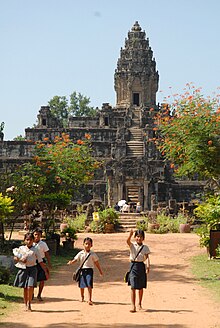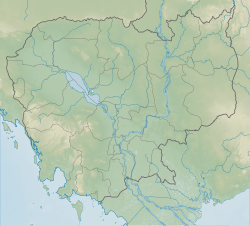Hariharalaya
ហរិហរាល័យ | |
 | |
| Alternative name | Roluos |
|---|---|
| Location | Siem Reap, Cambodia |
| Region | Southeast Asia |
| Coordinates | 13°20′N 103°58′E / 13.333°N 103.967°E |
| Type | Archaeological site |
| History | |
| Builder | Jayavarman II |
| Material | sandstone, laterite, brick |
| Founded | 9th century AD |
| Periods | Middle periods |
| Site notes | |
| Condition | ruined |
| Public access | Yes |
| Architecture | |
| Architectural styles | Preah Ko |
Hariharalaya (
Etymology

The name "Hariharalaya" is derived from the name of
History

Toward the end of the 8th century CE, the Cambodian king
Jayavarman II was succeeded by Jayavarman III and then by Indravarman I, who were responsible for the completion of the royal temple mountain known as the Bakong and the construction of Indratataka Baray.[4] Indravarman I consecrated the temple's dominant religious symbol, a lingam called Sri Indreshvara (the name is a combination of the king's name with that of Shiva), in 881 CE. Indravarman I also constructed the much smaller temple today called Preah Ko ("Sacred Bull"), dedicated in 880 CE. In 889 CE, Indravarman I was succeeded by his son Yasovarman I, who constructed the temple of Lolei (the name may be a modern corruption of "Hariharalaya") on an artificial island in the middle of Indratataka.[6] Yasovarman I also founded a new city at the site of Angkor Thom north of modern Siem Reap and called it Yaśodharapura. Yasovarman made the new city his capital and constructed a new royal temple mountain, known as Phnom Bakheng. Yasodharapura was to survive until the 1170s CE when it was sacked by invaders from Champa.[7]
See also
References
- Freeman, Michael and Jacques, Claude. Ancient Angkor. River Books. 2006. ISBN 974-8225-27-5.
- Falser, Michael. The Pre-Angkorian Temple of Preah Ko. A Sourcebook of the History, Construction and Ornamentation of the Preah Ko Style. White Lotos Publication. Bangkok 2006. (200 pages, ISBN 974-480-085-2)
Footnotes
- ISBN 9781842125847
- ISBN 9786167339443
- ISBN 978-0-7591-0279-8. pp.123-124
- ^ ISBN 978-0-8248-0368-1. p.110ff
- ^ Freeman and Jacques, p.9.
- ^ The reason for its offset towards the north seems to be that Indravarman closed off hastily the north side while preparing to move the capital to Angkor site, as in Freeman and Jacques, p.202
- ^ Freeman and Jacques, p.9ff.
External links
- Beyond Angkor: Historical Sites at Hariharalaya - Unique Graphical Interactive Maps and info about all the ancient historical sites

